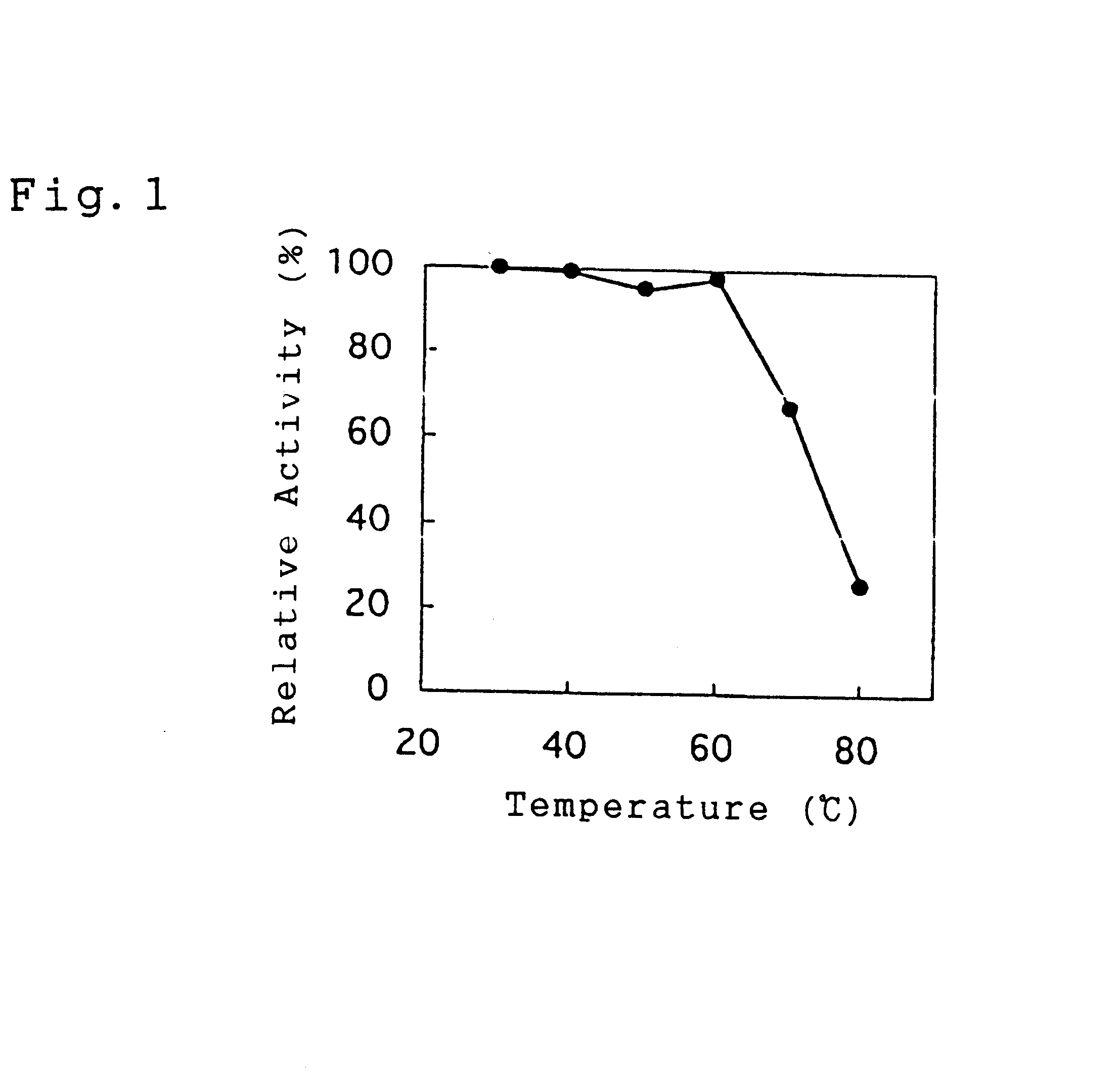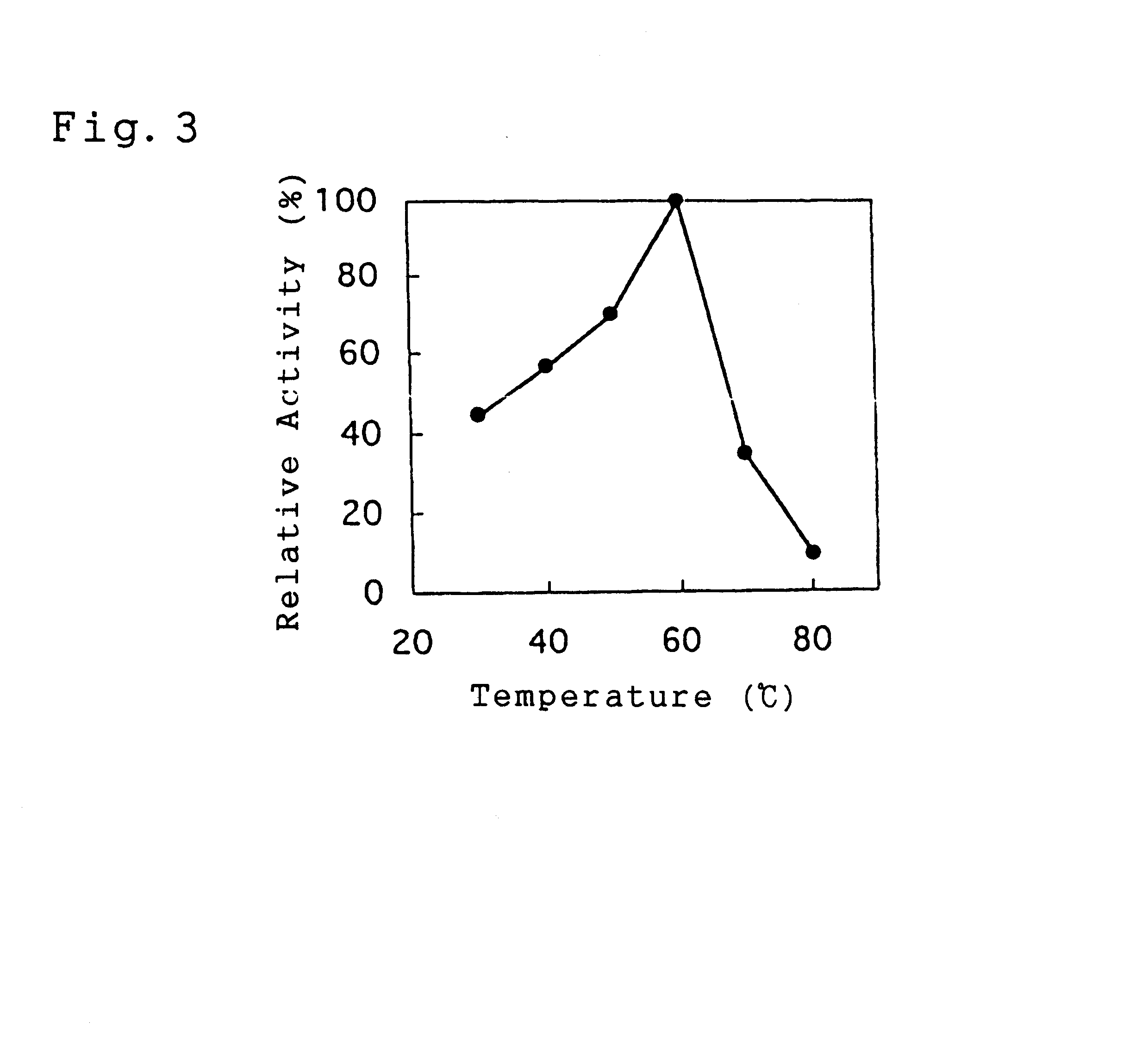Thermostable collagen-digesting enzyme, novel microorganism producing the enzyme and process for producing the enzyme
a technology of collagen and digesting enzyme, which is applied in the direction of microorganisms, enzymology, bacteria based processes, etc., can solve the problems of air pollution, many kinds of proteases are known to decompose difficult, and the degradation of collagen proceeds very slowly during composing
- Summary
- Abstract
- Description
- Claims
- Application Information
AI Technical Summary
Benefits of technology
Problems solved by technology
Method used
Image
Examples
example 1
Various kinds of specimen such as soils, composts, river and lake waters are diluted to 100-10,000 times with 0.85% NaCl, and 0.1 ml of said diluted solution was spread on GGY agar-agar medium, then are left for 2 or 3 days at 70.degree. C. The colony grown on medium was isolated and inoculated in 5 ml of GGY liquid medium and cultivated with shaking for 2 or 3 days at 70.degree. C. The collagen-decomposing enzyme activity of several hundred kinds of isolates are evaluated using the supernatant of culture according to the method described in Example 2.
The strain that indicates the highest collagen-decomposing activity was selected and named it NTAP-1 strain.
The taxonomical characteristics of NTAP-1 strain can be illustrated as follows.
(1) cell morphology: rod-shaped (0.8.times.2-3 .mu.m), curved and becomes chain form by aging.
(2) Gram's staining: negative or indefinite
(3) spore forming ability: yes
(5) motility: yes
(5) shape and characteristic of colonies: circular, corrugated or sl...
example 2
5 ml of medium (pH 4.8) containing 1.5% of glucose, 1.5% of gelatin and 0.01 % of yeast extract is poured into 5mi test tube and sterilized for 20 minutes at 120.degree. C. NTAP-1 (the shortened name of Bacillus genus NTAP-1 to discriminate the microorganism of this invention) is inoculated on said medium and cultivated with shaking for 4 days. The culture medium is centrifuged for 20 minutes at 8,000 r.p.m., and the activity of the thermostable collagen-decomposing enzyme in the supernatant is measured. Namely, 0.4 ml of enzyme liquid is mixed to 0.1 ml of 1M sodium acetate buffer (pH 4.5) and the mixture is pre-incubated for 5 minutes at 60.degree. C. Then 3mg of Azocoll (azo dye-linked collagen powder: product of Sigma Co., Ltd.) is suspended, and enzyme reaction is carried out at 60.degree. C. with stirring for 1 hour. After the reaction, the reaction mixture is chilled on ice, and insoluble Azocoll was separated by centrifugation.
During the enzyme reaction, Azocoll is decompose...
example 3
6 litter of same medium to Example 2 is poured into a jar fermentor of 10-liter vessel. After sterilized for 30 minutes at 120.degree. C., 200 ml of the NTAP-1 culture is inoculated on said medium. The cultivation is carried out at 60.degree. C. with 6 liters / min aeration for 4 days. The thermostable collagen-decomposing activity of the culture supernatant is measured. The activity of enzyme of the supernatant liquid is 5.0 U / ml.
The resultant supernatant was used as the starting material, the purification and concentration of thermostable collagen-decomposing enzyme was carried out according to the following process.
Ammonium sulfate is added to the supernatant liquid and the precipitate formed by ammonium sulfate 40% saturation was collected and dissolved in 585 ml of 0.01M acetate buffer (pH 5.0). Phenyl-Sepharose (product of AmeshamPharmacia Biotech.) was added to the solution, stirred and mixed for 1 hour, then the mixture was filtrated and the resin is separated. The enzyme acti...
PUM
| Property | Measurement | Unit |
|---|---|---|
| molecular weight | aaaaa | aaaaa |
| pH | aaaaa | aaaaa |
| pH | aaaaa | aaaaa |
Abstract
Description
Claims
Application Information
 Login to View More
Login to View More - R&D
- Intellectual Property
- Life Sciences
- Materials
- Tech Scout
- Unparalleled Data Quality
- Higher Quality Content
- 60% Fewer Hallucinations
Browse by: Latest US Patents, China's latest patents, Technical Efficacy Thesaurus, Application Domain, Technology Topic, Popular Technical Reports.
© 2025 PatSnap. All rights reserved.Legal|Privacy policy|Modern Slavery Act Transparency Statement|Sitemap|About US| Contact US: help@patsnap.com



